Last Tuesday, CW aired its second season premiere of The Flash, starring Grant Gustin as the titular DC Comics hero Barry Allen, a forensics scientist who becomes the fastest man alive. For many comic fans, this episode is major, marking the first time that live-action media is delving into the DC Multiverse (hinted at in the previous season finale) for a major season arc rather than only showing parallel worlds for an episode or two. But for those who haven’t read a lot of DC Comics or are intimidated by its many versions of Earth, don’t worry. Here’s a quick and friendly guide for you on how this multiverse came about and why it’s so fitting that The Flash is taking us there.
Many will tell you that DC Comics first introduced the idea of a multiverse in 1961 in Flash #123, but this isn’t true. We first saw parallel Earths in DC Comics in Wonder Woman #59, published in 1953 and produced by writer Robert Kanigher and artist H.G. Peter. In the story “Wonder Woman’s Invisible Twin,” Princess Diana of Paradise Island AKA Wonder Woman is holding her magic chain lasso when it’s struck by lightning, and the strange mix of energies sends her to a strange reality where she encounters an identical double.
This other woman introduces herself as Tara Terruna, explaining that this name translates to “Wonder Woman” on her planet. Diana (who was originally a scientist during her Golden Age era of comics) concludes “Earth must have a twin world, existing simultaneously alongside it! But developing differently!” Diana returned home by the story’s end and we never saw Princess Tara Terruna or her parallel Earth again.
Let’s now backtrack a little. The Golden Age of superheroes began in 1938 with the appearance of Superman. Following him, we got Batman, Wonder Woman, Captain America, Green Lantern, Flash, and many others. It was also during the Golden Age that the first superhero team ever was formed: the Justice Society of America. But after World War II, superheroes fell out of favor and many of them had their adventures canceled. Then in 1956, three years after Wonder Woman met her parallel Earth twin, DC Comics decided to reboot its superhero universe starting with the Flash.
The original Flash debuted in Flash Comics #1 in 1940. The story was that Jay Garrick, a university student with a promising career in science, accidentally knocks over some chemicals in his lab, causing them to mix and release a gas that renders him unconscious. As he sleeps, he breathes in the gas and his body is altered. When he awakes, he’s now the fastest man alive. He quickly shares his secret with his love interest Joan Allen (whom he marries years later) and embarks on a career as the heroic Flash. His costume marks him as a “modern-day Mercury,” involving a winged helmet. Although lightning had nothing to do with his abilities, he wore it as a symbol of speed and power.
Jay was popular and seems to have been the first superhero in history to be seen using his powers for recreation and fun rather than only when he needed to beat up a baddie. But, like many of his contemporaries, he later fell out of favor and vanished from comics.
The Silver Age of comics began when DC rebooted and reintroduced its superhero universe in 1956. The first Silver Age hero was a new version of the Flash. Now the story featured a forensic scientist and comic book fan named Barry Allen who is habitually late to meetings and dates.
One night, Barry’s in the crime lab when lightning crashes through the window and hits a metal chemical cabinet. The chemicals explode onto him and the electrified mixture plus direct contact with the lightning gives him superhuman speed. An altruistic man at heart, Barry decides to help other with these new abilities by becoming the Flash.
In Barry’s debut story, he’s seen reading an old Flash comic starring Jay Garrick. So DC was being very clear, this wasn’t the same continuity as the Flash character who had been out of comics for years. This was a new universe to explore, one where Jay was only a fictional character and the Justice Society of America didn’t exist. Soon, DC Comics introduced a new version of the Green Lantern, a new Atom, a new Hawkman and Hawkgirl, and so on. Some of these characters banded together as the Justice League of America, of which Barry Allen was the first chairman. By 1958, Superman and Wonder Woman also joined the Silver Age by having their own histories revised (unlike Flash and others, they maintained the same secret identities and basic origins).
Readers didn’t really mind this reboot. This was back when the average span of a comic book reader was about three years or so, and fans generally weren’t collecting and arguing over canon yet. Many readers who met Barry Allen in the 1950s weren’t even aware there had been a different Flash during the previous decade. Those who were aware didn’t really concern themselves. These were cartoon characters, after all, so continuity wasn’t something to take too seriously.
That attitude shifted in 1961. Writer Gardner Fox and editor Julius Schwartz decided it would be fun if the Golden Age Flash could come back for a story and meet his new Silver Age incarnation. So “Flash of Two Worlds” was published in Flash #123. As the Flash, Barry Allen can vibrate his molecules at different rates, so much so that he can even phase through solid matter like a ghost. While demonstrating these abilities to an audience, he vanishes and finds himself outside a city he doesn’t recognize. As a long time comic and sci-fi fan, Barry quickly wonders if he’s hit a space warp or has accidentally traveled through time. He hears music and follows it to a group of criminals who have put this city to sleep. Barry quickly realizes that he is in the world of Jay Garrick. Here, Jay isn’t fictional, he’s real!
Barry finds Jay and introduces himself. He concludes that there are many Earths co-existing at different vibrational frequencies. He hit the right frequency and it allowed him to shift through dimensions. Barry also suggests that some writers and artists on his world somehow subconsciously tapped into information about other Earths, meaning the comics Barry read about Jay Garrick were unintentionally chronicling real events of another world. Since Barry is the first parallel Earth traveler, as far as he knows, he refers to his world of modern day heroes as Earth-One and to Jay’s world of heroes who originally fought during the World War II era (and then mostly retired) as Earth-Two.
Barry helps Jay against the villains who put his city to sleep and then returns to Earth-One. But unlike Wonder Woman’s story of a twin, Barry and Jay continued to meet and join forces. This led to regular team-ups between their respective groups, the Justice League and Justice Society, and trips to yet more parallel worlds, including the mirror reality known as Earth-3 where all the superheroes we know and love are villains and the only superhero is Lex Luthor. A DC multiverse was born!
Along with this, DC Comics started buying up characters from smaller comic book companies going out of business. DC would then treat the new characters as inhabitants of yet another Earth. The heroes of Quality Comics were revealed to live on Earth-X, a world where the Nazis weren’t defeated in 1945. The characters of Charlton Comics (who were later reimagined for Alan Moore’s Watchmen) were said to inhabit Earth-4. And so on. These worlds were largely kept separate, except for the occasional crossover.
In the 1980s, DC decided that it needed another reboot to make its heroes relevant to the new comic book audience. What’s more, the multiverse was deemed too scary and confusing for new readers. So in 1985, a huge crossover even began entitled Crisis on Infinite Earths. It ended a year later and resulted in the birth of a new Post-Crisis DC Universe, one that integrated many of the previously existing parallel Earths.
Now, Jay Garrick and Barry Allen existed in the same reality and timeline, different generations of the same heroic legacy. Originally called simply “Post-Crisis Earth,” this rebooted reality was later officially designated “Earth-Zero” after some revisions and alterations were made.
Over time, many readers and creators missed the multiverse and how much room it gave to play with characters and stories. DC produced several “Elseworlds” books that reimagined characters in fun and sometimes bizarre ways, but none of these were considered “canon” or were meant to really crossover with the mainstream universe.
In 1994 and 2005-2006, the crossovers Zero Hour and Infinite Crisis (sequels to Crisis on Infinite Earths) both featured a villain attempting to bring the old multiverse back. In 2007, DC Comics created a new multiverse, now saying that the mainstream Earth Zero was one of 52 co-existing Earths. It’s now become a running gag for the number 52 to appear in various DC stories, including the TV shows. Look for it, folks!
In 2011, DC truly rebooted its mainstream Earth Zero universe again. The feeling was that the Post-Crisis universe had now gathered quite a bit of history, and a few too many contradictory revisions, during the 25 years since Crisis on Infinite Earths ended. DC wanted to streamline its reality again, especially now that live-action TV shows and movies might be bringing in new readers.
This third across-the-board DC Universe reboot is called “The New 52,” named so because DC Comics canceled their titles and released 52 new ones. There’s still a multiverse of 52 Earths, but now the history and nature of Earth Zero, as well as its inhabitants, are markedly different. Whether the New 52 reboot streamlined things or is just as complicated as the Post-Crisis universe is often debated.
In the New 52 status quo, we’re back to the idea that Jay Garrick and the Golden Age DC characters live in a separate universe, the reborn Earth Two, rather than alongside the mainstream heroes of Earth Zero. Writer Grant Morrison recently explored the possibilities of these parallel Earths in his mini-series Multiversity, which included a map of the many worlds and dimensions of DC Comics.
DC has also released graphic novels that take place on a new “Earth One,” intended to be a more grounded reimagining certain DC characters. So far, the Earth One graphic novels don’t even crossover with each other, so it’s not known if we’ll ever see those characters really interact with the rest of the DC Multiverse.
This all may seem a bit daunting and confusing. You’ve got two different Battlestar Galactica realities, two different Star Trek timelines (plus alternate timelines and the Mirror Universe), and now you’ve seen there are basically four versions of the mainstream DC Universes: Golden Age, Silver Age, Post-Crisis and New 52. But honestly, the multiverse is just a large playground where we get to remember that comics and superheroes can do and be anything. It’s where we get to embrace the sheer fun of asking hey, what if Batman met a version of himself who was really a vampire? What if there’s an Earth where Superman is black and President of the U.S.A.? What if…?
So that’s what’s really exciting about Jay Garrick appearing on CW’s The Flash and saying he’s from another Earth. It’s not just about getting to see two generations of the Flash legacy finally teaming up. It’s holding up a sign that says anything is possible now. Maybe there can even be a crossover between the DC Entertainment TV shows and the Warner Bros. DC Comics films. Where some superhero shows and movies try to limit themselves to what’s deemed “more realistic” for live action media, The Flash unapologetically embraces its absurdist comic book roots. Like the best fiction, it’s not afraid to ask “what if?” It’s not afraid to say “just imagine.” And that’s fantastic.
Alan Sizzler Kistler (@SizzlerKistler) is an actor and freelance writer, as well as the author of the New York Times Best Seller Doctor Who: A History. He is the creator and host of the podcast Crazy Sexy Geeks.











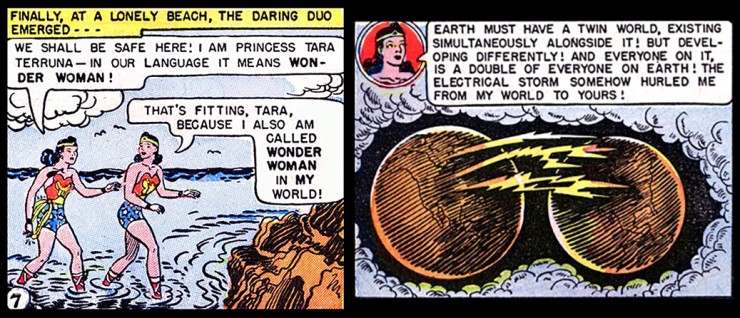
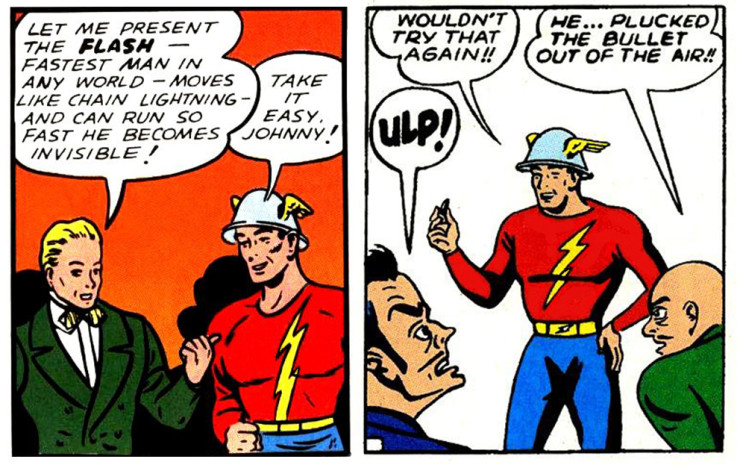
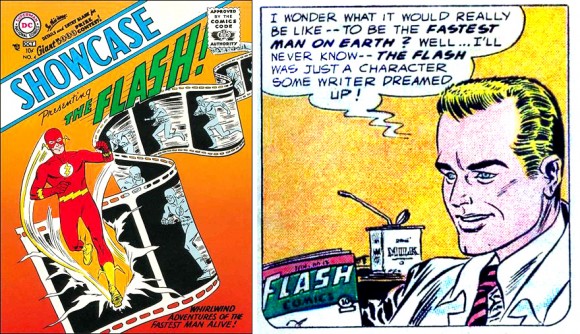
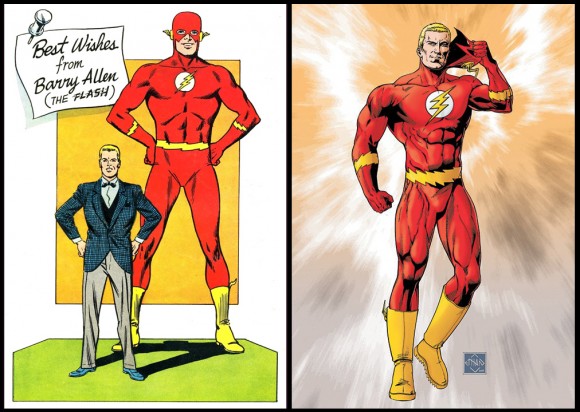

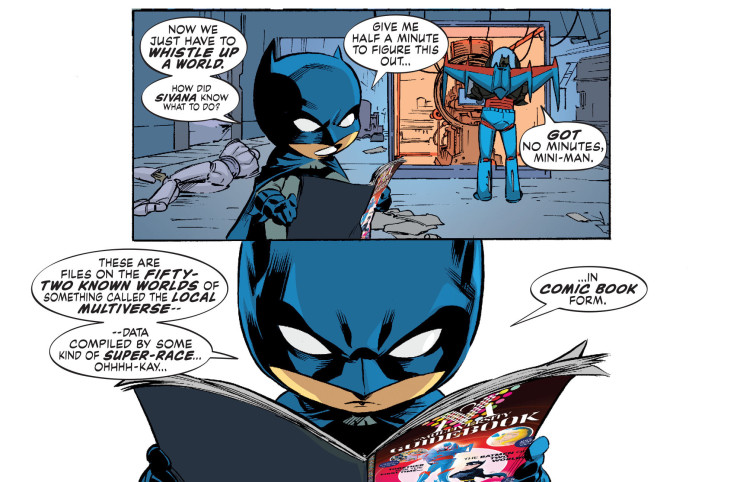
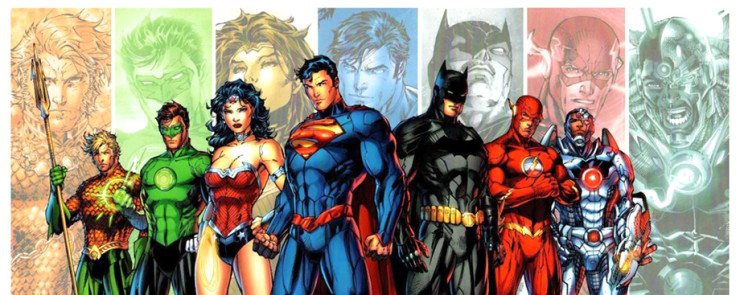
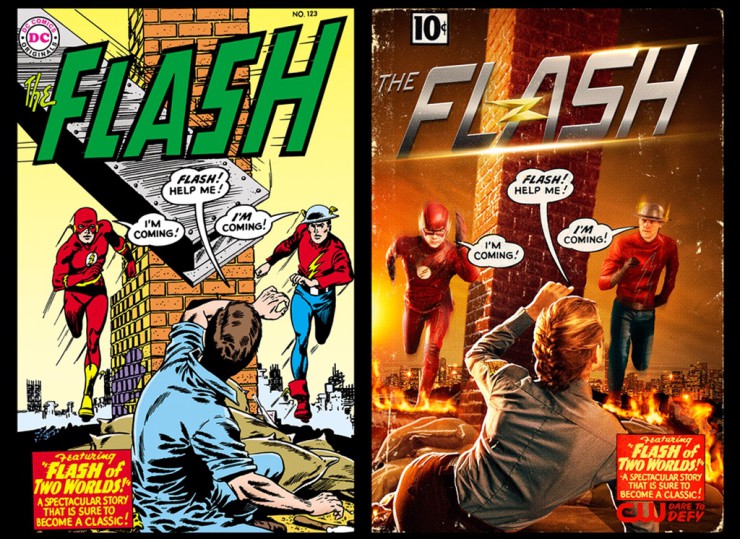
Point of order: this is NOT the first time that live-action media is delving into the multiverse. Superboy did it years ago, in a two-part infinite-Earths episode in which Ron “Doc Savage”/”Tarzan” Ely played an elderly Superman (though they couldn’t use the name). (This means that Ron Ely has played both The Man of Bronze and The Man of Steel, in addition to Tarzan.)
Thanks for the explanation.
I guess my beef with the TV show taking on all this is that a comic book needs that freedom to tell new stories. Otherwise they get locked into ruts or contradictions. I don’t think a TV show needs that unless its being going on as long as (say) Doctor Who.
It’ll be fine as long as its used the way it started in the comic books: an occasional flavoring. If they start throwing infinite worlds around (or even just 52) then its going to be hard for them to establish ground rules or make me care about any of it. Imagine if Star Trek had featured the mirror universe, or multiple mirror universes, as the main story arc? Well I suppose good writers could have pulled it off, but it would be a very different story.
I’m not just picking on DC here. Marvel’s rush to pull their entire pantheon into the movies and tie-ins is probably going to limit them in the end. Instead of just making a good Spider-Man movie for instance they’ll be stuck maintaining continuity and trying to explain why no other heroes are around to bail Spidey out. (Early warning sign: there was a telling, kinda lame line in Iron Man 3, trying to explain why Stark couldn’t get help from the Avengers.)
(Granted, I like a good superhero movie but I’m not invested in the comic book universes themselves. Whereas the comic book geeks I know love that all this continuity is being pulled in. So maybe the movies will mostly be good and I’ll be proven wrong.)
#2 – The episode, Flash of Two Worlds, was a pretty simplistic introduction to the multiverse, which is going to let the TV DC universe go in some directions that apparently WB is not allowing them (for example, they can’t use Superman or Batman – or Gotham/Metropolis – in either the Arrow or the Flash, although they are allowing ‘cousin’ references, based on the trailers, in Supergirl, by essentially some of the same production crew). I don’t really have a problem with that, either a comic book fan or a casual viewer. I have no clue about Marvel comic books but haven’t really found myself too confused about the main points in the MCU and where I didn’t know (infinity rocks?), that’s what sites like this or Wikipedia are for. A bigger complaint for me, so far, would be using another speedster as the main villain for S2, frankly.
To the author, thanks for this, it’s a nice, clean simple explanation of the multiverse, even going as far as touching on the various Crisis events (which probably wasn’t necessary and is part of what intimidates casuals).
A friend of mine recently explained to me how the new Star Wars books were ditching the canon of the old expanded universe (now referred to as the Legends canon.) My immediate reaction: “You know what that means? One day they’re going to do Crisis on Infinite Tatooines.”
I was only partly joking. I can easily imagine some kind crossover between the two universes in 10 years or so. Most of me is horrified, but a small part thinks it would be fun. (Oh, that Dark Side! How seductive it is.)